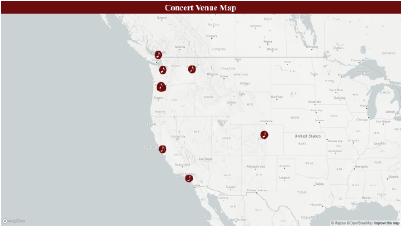Charts

Click to view full size
In the back of a concert venue, one can find a corner table filled with merchandise from the band.
Merchandise are an essential link between bands, concerts, and their fans. Fans “love owning a
physical piece of the band. It’s a statement of their support, and of their belonging to a fanbase
that they are proud to be a part of”, according to the article “Music & Merch: A Guide to Selling
Merchandise for Bands” (“Music & Merch”). Syd, Izzy, and Kai listed all of their merchandise from
the years in their spreadsheet and it was Izzy’s job to organize it.
Physically organizing the merchandise, which employs the first order of order, could only occur in
one way. Digitally, in an infographic, there are many ways we can organize the merchandise. Izzy chose
to sort the merchandise three different ways. The main piechart broke down the merchandise into broad
categories, then broke down further into specific categories, and finally listed the merchandise itself.
With 58 pieces of merchandise, deciding the broad categories was interesting. Defining broad categories
lead to the creation of categories such as Wearable Merch, Signed Items, and Miscellany. This natural way
of organization allowed the merchandise to easily be sorted into the appropriate categories.
After breaking down the merchandise from broad categories to specifics, Izzy chose to include the specific
band related to the merchandise, as well as the person who bought it. This extra metadata about the merchandise
allowed for more forms of organization. Smaller pie charts were created to showcase the percentage of merch by
owner and the percentage of merch related to bands. This second order method of organization allowed for multiple
ways to sort the information, and being able to do it digitally made it easier given the abundance of metadata
that we were able to provide. If Izzy chose to include more information like dates and location in the main
infographic, more small charts could have been made. Metadata is the key to organizing information. This
infographic, lovingly named the “Pie-robilia”, is a prime example of how digitally organizing information
can be formed in many different ways to suit the individual user.

Click to view full size
Time is a line that is constantly moving forward. Organizing time, even though it is not a physical matter,
can only occur in a straight line that is always moving forward. We remember concerts as far back as 2006,
so it was a fun idea to organize the concerts by date, which led Izzy to create the concert dates infographic.
Taking the concert dates and sorting them occurs in the first order of order, and even when done digitally it
is the only way time can be organized. Izzy organized the dates from the very first concert Kai saw in June 2006,
all the way to the most recent concert seen by Izzy in October of 2019. Adding a little bit of extra metadata,
like adding which girl went to which concert, opens the door to organizing the concerts by girl and date, but the
timeline would still be moving in a straight line. Some small branches leap out to signify the specific dates, but
then the line of time keeps moving forward. This form of organization is arbitrary and natural. We organize time in
a straight line our whole lives, and it is often easiest and most natural to organize events by their dates.



